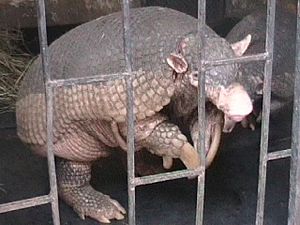Giant Armadillo facts for kids
Quick facts for kids Armadillo raksasa |
|
|---|---|
 |
|
| Conservation status | |
| Scientific classification | |
| Kingdom: | |
| Phylum: | |
| Class: | |
| Order: | |
| Family: | |
| Subfamily: |
Tolypeutinae
|
| Genus: |
Priodontes
|
| Species: |
P. maximus
|
| Binomial name | |
| Priodontes maximus (Kerr, 1792)
|
|
The Giant Armadillo (Priodontes maximus) is the biggest type of armadillo alive today. People also call it Tatou, Ocarro, Tatu-canastra, or Tatú Carreta.
These amazing animals used to live all over the tropical forests in eastern South America. Now, you can find them in many different places. Their home stretches as far south as northern Argentina.
Contents
What Does a Giant Armadillo Look Like?
The giant armadillo is the largest living armadillo. It has 11 to 13 special bands on its body that can move. These bands act like armor, protecting its body. It also has three or four more bands on its neck.
Its body is dark brown. A lighter, yellowish stripe runs along its sides. Its head is a pale, yellow-white color.
Teeth and Claws
Giant armadillos have a lot of teeth, usually between 80 and 100. This is more than almost any other land mammal. All their teeth look similar. They are simple teeth that grow all the time. They also do not have enamel, which is the hard outer layer on human teeth.
These armadillos have super long front claws. One claw, the third one, is shaped like a sickle. These claws are the biggest for their body size of any living mammal. They are perfect for digging!
Skin and Tail
The armadillo's tail is covered in small, round scales. It doesn't have the heavy, bony plates called scutes. These scutes cover the armadillo's upper body and the top of its head. The animal has almost no hair. Only a few beige hairs stick out between its scutes.
Size and Weight
Adult giant armadillos usually weigh about 18.7 to 32.5 kilograms (41 to 72 pounds). That's like two big bags of dog food! However, some have been found weighing up to 54 kg (119 lb) in the wild. Armadillos in zoos have weighed even more, up to 80 kg (176 lb).
Their body length is usually 75 to 100 centimeters (30 to 39 inches). Their tail adds another 50 cm (20 inches) to their total length.
Where Do Giant Armadillos Live?
Giant armadillos live in many parts of northern South America. You can find them east of the Andes mountains. However, they are not found in eastern Brazil and Paraguay.
In the southern parts, they reach the northern areas of Argentina. This includes places like Salta, Formosa, Chaco, and Santiago del Estero. There are no different types of giant armadillos based on where they live.
They mostly live in open areas. About 25% of their home is in cerrado grasslands. These are like open plains with some trees. But they can also live in lowland forests.
How Do Giant Armadillos Behave?

Giant armadillos are nocturnal, meaning they are active at night. They are also solitary, which means they like to be alone. During the day, they sleep in burrows they dig.
They also dig burrows to hide from animals that might try to eat them. Unlike some other armadillos, they cannot completely roll into a ball to protect themselves. Their burrows are very big compared to other armadillos' homes. The entrance to their burrow is usually about 43 cm (17 inches) wide. They often dig their burrows to open towards the west.
What Do They Eat?
Giant armadillos use their huge front claws to dig for food. They can even rip open tough termite mounds! Their main food is termites. But they also eat ants, worms, spiders, and other small creatures without backbones.
Their Role in Nature
Scientists haven't studied armadillos much in the wild. So, we don't know everything about how they live. However, one long study in the Peruvian Amazon began in 2003. It found that many other animals use the giant armadillos' burrows. These include mammals, reptiles, and birds, even the rare short-eared dog.
Because of this, the giant armadillo is called a "habitat engineer." This means they change their environment in a way that helps other species. If giant armadillos disappear from an area, it could harm other animals. These animals rely on the burrows for shelter.
Reproduction and Life Cycle
Female giant armadillos have two teats. They are thought to usually give birth to only one baby each year. Not much is known about their life cycle. Scientists think the babies stop drinking milk around seven or eight months old.
The mother armadillo sometimes seals the entrance to burrows where her young babies are. This is probably to keep them safe from predators. Giant armadillos have never had babies in zoos. However, one armadillo born in the wild lived to be about sixteen years old at the San Antonio Zoo.
Images for kids
-
The skeleton of a giant armadillo with a six-banded armadillo skeleton (bottom right) at the Cambridge University Museum of Zoology in England
See also
 In Spanish: Armadillo gigante para niños
In Spanish: Armadillo gigante para niños



